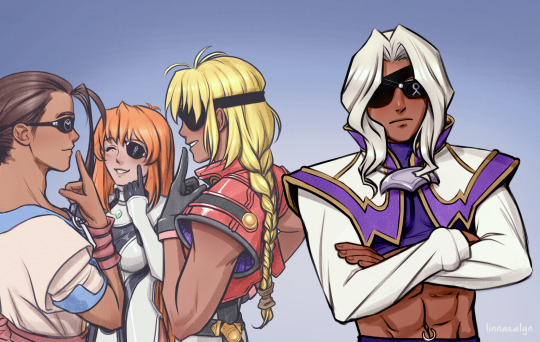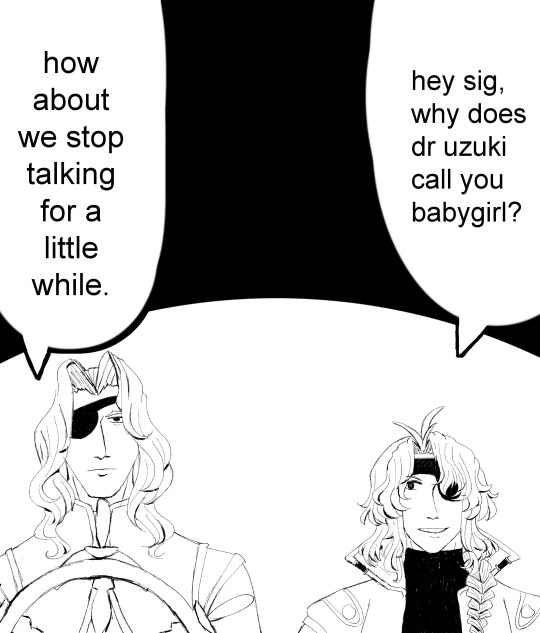#Sigurd Harcourt
Explore tagged Tumblr posts
Text

The captain and his first mate
#xenogears#bartfatima#bartholomewfatima#bart fatima#bartholomew fatima#sigurdharcourt#sigurd harcourt
11 notes
·
View notes
Text

context:

#Xenogears#Fei Fong Wong#Elehayym van Houten#Elhaym van Houten#Bartholomew Fatima#Sigurd Harcourt#my art#sillies#xg ot3#PW ep5
26 notes
·
View notes
Photo

#xenogears#bartholomew fatima#sigurd harcourt#this has been in my folder since.... october 2022 lol#wanted to put more xenogears drawings alongside it but did not have the time
65 notes
·
View notes
Note
are there any xenogears characters in? i submitted two a while back but i have no idea how big the backlog is so idk if they went through or are just on the way
No polls with Xenogears characters have been posted yet. Bartholomew Fatima, Sigurd Harcourt, and Fei Fong Wong have been submitted.
#asks#submitted characters asks#xenogears#in terms of the backlog#there are around#1500 characters that haven’t been run yet#so uhhh#we’re gonna be here a while
9 notes
·
View notes
Note
Roni's hair looking like that is probably because he's the ancestor of Bartholomew "Bart" Fatima, one of the main characters

Also I remembered another Final Fantasy VI reference on that game, Bart's half brother Sigurd Harcourt has the same last name as Duncan Harcourt, Sabin's martial arts master

(Not sure why the artist didn't include his arms but did include his abdomen for this artwork)


Roni Fatima and Rene Fatima, minor characters from Xenogears based on Edgar Roni Figaro and Sabin Rene Figaro from Final Fantasy VI. They're only relevant to part of Krelian's backstory since they're long dead by the time the story starts.


Lucca from Chrono Trigger appears in Lahan village to explain save points and the Italian senator makes a cameo on a poster in Solaris.
Ponytail makes me think of Cyan, but younger.
Does have the short hair Sabin thing too, just the wrong colour iirc.
Either way I love how they do that, and I totally missed that Italian senator line and was about to point out that she's back there.
lol
4 notes
·
View notes
Photo

Xenogears x Good Place? Well, why not.
69 notes
·
View notes
Photo

I’m like barely thirty parts away from finishing that one Xenogears LP and this is the first fucking thing I draw for this game
Referencing this
7 notes
·
View notes
Photo

Day 8 of Inktober! Noodler's X-Feather Platinum Preppy02
#234: Mneh, I'm not happy with how Sigurd turned out. It was just one of those days I was having trouble drawing--I erased and redrew him so many times, and finally gave up.
I'll come back to his design another time.
Do not remove description/repost without credit.
#inktober#inktober2017#xenogears#artists on tumblr#artists of tumblr#sketch#drawing#doodle#illustration#character#redesign#sigurd harcourt#art#art journal#hobonichi#fountain pen#ink
17 notes
·
View notes
Photo

Revisiting Xenogears; Sigurd! Your other eye patch buddy!
Even though I want to clean this up a bit more, I’m sharing this now in case I don’t get around to cleaning it up.
#xenogears#sigurd#sigurd (xenogears)#sigurd harcourt#well at least i now know there's concept art for sigurd#hopefully i'll find some for future xenogears drawings#so no more guessing from the sprites...
33 notes
·
View notes
Text

Fatima Jasper

It gets hot in the desert :)
#xenogears#bartholomewfatima#bartfatima#bartholomew fatima#bart fatima#sigurdharcourt#sigurd harcourt
2 notes
·
View notes
Text

In which Sigurd has turned the corner of the gun room bar into an espresso cubby and takes up the hobby post-game.
Yeah, I can see that.
Wanted to draw him more like Soraya Saga does. My favorite version of Sigurd. 😍
#Xenogears#Sigurd Harcourt#Sigurd Xenogears#my art#cirrustea's prompt#essentially#(over on insta)#PW ep6
48 notes
·
View notes
Text

68 notes
·
View notes
Text
Fantasieherz, schöner Verstand. Pt XVIII Veröffentlichung.

Beowulf: The Monsters and the Critics
As well as his fiction, Tolkien was also a leading author of academic literary criticism. His seminal 1936 lecture, later published as an article, revolutionized the treatment of the Anglo-Saxon epic Beowulf by literary critics. The essay remains highly influential in the study of Old English literature to this day. Beowulf is one of the most significant influences upon Tolkien's later fiction, with major details of both The Hobbit and The Lord of the Rings being adapted from the poem. The piece reveals many of the aspects of Beowulf which Tolkien found most inspiring, most prominently the role of monsters in literature, particularly that of the dragon which appears in the final third of the poem:
As for the poem, one dragon, however hot, does not make a summer, or a host; and a man might well exchange for one good dragon what he would not sell for a wilderness. And dragons, real dragons, essential both to the machinery and the ideas of a poem or tale, are actually rare.
Children's books and other short works
In addition to his mythopoeic compositions, Tolkien enjoyed inventing fantasy stories to entertain his children. He wrote annual Christmas letters from Father Christmasfor them, building up a series of short stories (later compiled and published as The Father Christmas Letters). Other works included Mr. Bliss and Roverandom (for children), and Leaf by Niggle (part of Tree and Leaf), The Adventures of Tom Bombadil, Smith of Wootton Major and Farmer Giles of Ham. Roverandom and Smith of Wootton Major, like The Hobbit, borrowed ideas from his legendarium.
The Hobbit
Tolkien never expected his stories to become popular, but by sheer accident a book called The Hobbit, which he had written some years before for his own children, came in 1936 to the attention of Susan Dagnall, an employee of the London publishing firm George Allen & Unwin, who persuaded Tolkien to submit it for publication. When it was published a year later, the book attracted adult readers as well as children, and it became popular enough for the publishers to ask Tolkien to produce a sequel.
The Lord of the Rings
The request for a sequel prompted Tolkien to begin what would become his most famous work: the epic novel The Lord of the Rings (originally published in three volumes 1954–1955). Tolkien spent more than ten years writing the primary narrative and appendices for The Lord of the Rings, during which time he received the constant support of the Inklings, in particular his closest friend C. S. Lewis, the author of The Chronicles of Narnia. Both The Hobbit and The Lord of the Rings are set against the background of The Silmarillion, but in a time long after it.
Tolkien at first intended The Lord of the Rings to be a children's tale in the style of The Hobbit, but it quickly grew darker and more serious in the writing.[159] Though a direct sequel to The Hobbit, it addressed an older audience, drawing on the immense backstory of Beleriand that Tolkien had constructed in previous years, and which eventually saw posthumous publication in The Silmarillion and other volumes. Tolkien's influence weighs heavily on the fantasy genre that grew up after the success of The Lord of the Rings.
The Lord of the Rings became immensely popular in the 1960s and has remained so ever since, ranking as one of the most popular works of fiction of the 20th century, judged by both sales and reader surveys. In the 2003 "Big Read" survey conducted by the BBC, The Lord of the Rings was found to be the UK's "Best-loved Novel". Australians voted The Lord of the Rings "My Favourite Book" in a 2004 survey conducted by the Australian ABC. In a 1999 poll of Amazon.com customers, The Lord of the Rings was judged to be their favourite "book of the millennium". In 2002 Tolkien was voted the 92nd "greatest Briton" in a poll conducted by the BBC, and in 2004 he was voted 35th in the SABC3's Great South Africans, the only person to appear in both lists. His popularity is not limited to the English-speaking world: in a 2004 poll inspired by the UK's "Big Read" survey, about 250,000 Germans found The Lord of the Rings to be their favourite work of literature.
Posthumous publications
The Silmarillion
Tolkien wrote a brief "Sketch of the Mythology", which included the tales of Beren and Lúthien and of Túrin; and that sketch eventually evolved into the Quenta Silmarillion, an epic history that Tolkien started three times but never published. Tolkien desperately hoped to publish it along with The Lord of the Rings, but publishers (both Allen & Unwin and Collins) declined. Moreover, printing costs were very high in 1950s Britain, requiring The Lord of the Rings to be published in three volumes. The story of this continuous redrafting is told in the posthumous series The History of Middle-earth, edited by Tolkien's son, Christopher Tolkien. From around 1936, Tolkien began to extend this framework to include the tale of The Fall of Númenor, which was inspired by the legend of Atlantis.
Tolkien had appointed his son Christopher to be his literary executor, and he (with assistance from Guy Gavriel Kay, later a well-known fantasy author in his own right) organized some of this material into a single coherent volume, published as The Silmarillion in 1977. It received the Locus Award for Best Fantasy novel in 1978.
Unfinished Tales
and
The History of Middle-earth
In 1980, Christopher Tolkien published a collection of more fragmentary material, under the title Unfinished Tales of Númenor and Middle-earth. In subsequent years (1983–1996), he published a large amount of the remaining unpublished materials, together with notes and extensive commentary, in a series of twelve volumes called The History of Middle-earth. They contain unfinished, abandoned, alternative, and outright contradictory accounts, since they were always a work in progress for Tolkien and he only rarely settled on a definitive version for any of the stories. There is not complete consistency between The Lord of the Rings and The Hobbit, the two most closely related works, because Tolkien never fully integrated all their traditions into each other. He commented in 1965, while editing The Hobbit for a third edition, that he would have preferred to completely rewrite the book because of the style of its prose.
Mr. Bliss
One of Tolkien's least-known short works is the children's storybook Mr. Bliss, published in 1982. It tells the story of Mr. Bliss and his first ride in his new motor-car. Many adventures follow: encounters with bears, angry neighbours, irate shopkeepers, and assorted collisions. The story was inspired by Tolkien's own vehicular mishaps with his first car, purchased in 1932. The bears were based on toy bears owned by Tolkien's sons. Tolkien was both author and illustrator of the book. He submitted it to his publishers as a balm to readers who were hungry for more from him after the success of The Hobbit. The lavish ink and coloured-pencil illustrations would have made production costs prohibitively expensive. Tolkien agreed to redraw the pictures in a simpler style, but then found he did not have time to do so. The book was published in 1982 as a facsimile of Tolkien's difficult-to-read illustrated manuscript, with a typeset transcription on each facing page.
The Children of Húrin
More recently, in 2007, The Children of Húrin was published by HarperCollins (in the UK and Canada) and Houghton Mifflin (in the US). The novel tells the story of Túrin Turambar and his sister Nienor, children of Húrin Thalion. The material was compiled by Christopher Tolkien from The Silmarillion, Unfinished Tales, The History of Middle-earth, and unpublished manuscripts.
The Legend of Sigurd and Gudrún
The Legend of Sigurd and Gudrún, which was released worldwide on 5 May 2009 by HarperCollins and Houghton Mifflin Harcourt, retells the legend of Sigurd and the fall of the Niflungs from Germanic mythology. It is a narrative poem composed in alliterative verse and is modelled after the Old Norse poetry of the Elder Edda. Christopher Tolkien supplied copious notes and commentary upon his father's work.
According to Christopher Tolkien, it is no longer possible to trace the exact date of the work's composition. On the basis of circumstantial evidence, he suggests that it dates from the 1930s. In his foreword he wrote, "He scarcely ever (to my knowledge) referred to them. For my part, I cannot recall any conversation with him on the subject until very near the end of his life, when he spoke of them to me, and tried unsuccessfully to find them." In a 1967 letter to W. H. Auden, Tolkien wrote,
Thank you for your wonderful effort in translating and reorganising The Song of the Sibyl. In return again I hope to send you, if I can lay my hands on it (I hope it isn't lost), a thing I did many years ago when trying to learn the art of writing alliterative poetry: an attempt to unify the lays about the Völsungs from the Elder Edda, written in the old eight-line fornyrðislag stanza.
The Fall of Arthur
The Fall of Arthur, published on 23 May 2013, is a long narrative poem composed by Tolkien in the early-1930s. It is alliterative, extending to almost 1,000 lines imitating the Old English Beowulf metre in Modern English. Though inspired by high medieval Arthurian fiction, the historical setting of the poem is during the Post-Roman Migration Period, both in form (using Germanic verse) and in content, showing Arthur as a British warlord fighting the Saxon invasion, while it avoids the high medieval aspects of the Arthurian cycle (such as the Grail, and the courtly setting); the poem begins with a British "counter-invasion" to the Saxon lands (Arthur eastward in arms purposed).
Beowulf: A Translation and Commentary
Beowulf: A Translation and Commentary, published on 22 May 2014, is a prose translation of the early medieval epic poem Beowulf from Old English to modern English. Translated by Tolkien from 1920 to 1926, it was edited by his son Christopher. The translation is followed by over 200 pages of commentary on the poem; this commentary was the basis of Tolkien's acclaimed 1936 lecture "Beowulf: The Monsters and the Critics".[171] The book also includes the previously unpublished "Sellic Spell" and two versions of "The Lay of Beowulf". The former is a fantasy piece on Beowulf's biographical background, while the latter is a poem on the Beowulf theme.
The Story of Kullervo
The Story of Kullervo, first published in Tolkien Studies in 2010 and reissued with additional material in 2015, is a retelling of a 19th-century Finnish poem. It was written in 1915 while Tolkien was studying at Oxford.
Beren and Lúthien
The Tale of Beren and Lúthien is one of the oldest and most often revised in Tolkien's legendarium. The story is one of three contained within The Silmarillion which Tolkien believed to warrant their own long-form narratives. It was published as a standalone book, edited by Christopher Tolkien, under the title Beren and Lúthien in 2017.
The Fall of Gondolin
The Fall of Gondolin is a tale of a beautiful, mysterious city destroyed by dark forces, which Tolkien called "the first real story" of Middle-earth, was published on 30 August 2018 as a standalone book, edited by Christopher Tolkien and illustrated by Alan Lee.
2 notes
·
View notes
Note
➰

Sigurd Harcourt from Xenogears. I actually ran the game on LJ, and it was an AU, like, a new world made up for the characters to fit in. There was a point where we had quite a few characters, and it was a lot of fun. And a lot of pain in the ass, too. I mean, I totally get dyslexia, but if I can’t make heads or tails of a post, then it’s not working. Or if the character’s core personality changes according to the situation, that’s... not fun on the long run, either.
However, I found a long-lasting friend in that game and I’m still thankful for that. We worked together for about ten years or so.
As for Sig, he's very much the type of guy I normally play: chivalrous, gentle, considerate, but also a rather decent fighter. Not to mention the gorgeous aesthetics.
2 notes
·
View notes
Photo




Xenogears stuff.
36 notes
·
View notes
